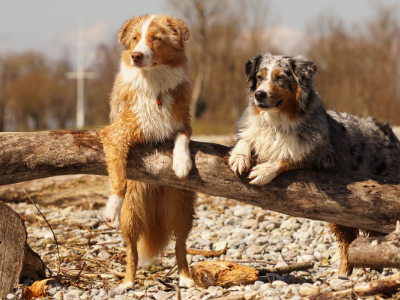6 Ways to Prevent Dysplasia in Your Large Breed Puppy

Is your puppy’s breed susceptible to dysplasia? Worried that you might be contributing it without knowing?
The truth of the matter is that dysplasia has been considered a genetic disease in many predisposed large breed or giant breeds, such as Shepherds, Mastiffs, and Great Danes.
So what is dysplasia? Dysplasia refers to a malformation of the joint which is likely to develop within the first year to a year and a half of a puppy’s life. Over time, the joints deteriorate causing pain, loss of mobility, stiffness, and even muscle loss. Even though this is often attributed to specific breeds, it can be related to a dog’s environment. For example, rapid weight gain, or poor nutrition can contribute. So what are some common preventative measures you can take?
Can Dogs and Cats Be Vegetarians?

There are a number of vegetarians and vegans out there looking for ways to keep their pets healthy without feeding meat or animal products. The question is: can dogs and cats be healthy for their entire lifetime eating this way? While it’s a romantic idea, the answer is, almost undeniably, no. While there are some vegetarian diets that can sustain dogs, you will find it is not ideal. Cats cannot be fed anything except a meat-based diet. They cannot use vegetable proteins to sustain themselves and will die without animal tissue in their diet. If you are a vegan and cannot bring yourself to handle meat products, a carnivorous animal is not for you!
Human Grade Vs. Natural Meats: Affordability Vs. Quality

What's the difference between our "regular" line and our "natural" line? We get this question a lot. I wanted to address it so people understand the differences in meat quality across the board, not just with our products but with commercially prepared raw pet foods in general.
There are several "grades" of meat that you can purchase for your pet. 3P uses only 2 grades: human-grade (our regular line) and natural-grade. There are other grades of meat as well, but we will talk about these two first. Below are the differences so that you can make the most informed decision about what to feed your pet.
Does Raw Pet Food Meet AAFCO Standards?

This is probably one of the more controversial posts I will make on our blog. I feel strongly about this subject and hope that through my learning, I can help others learn too. Often, I am told by pet owners that their vets have asked them to check with us, as a raw pet food manufacturer, on whether or not our raw foods meet AAFCO standards. AAFCO is the American Association of Food Control Officials. They write standards that veterinarians and pet food manufacturers to follow to ensure that all required nutrients are available in pet food….or so they say…. Let’s look a little closer look at all of this.
In a recent online seminar conducted by Dogs Naturally Magazine during their popular Raw Roundup seminar series, Dr. Ian Billinghurst, DVM spoke on the confusing subject of AAFCO standards and why it might not be the holy grail of how to distinguish the nutritional integrity of your pet’s food. For those of you who don’t already know who Dr. Billinghurst is, he is the author of “Give Your Dog A Bone” and “The BARF Diet for Dogs and Cats.” He was one of the first vets to speak out about the detrimental effects of processed pet foods and to teach pet owners and vets about feeding a biologically appropriate diet. This article is a product of what I learned while participating in Dr. Billinghurt’s informative talk and what I have learned about pet food of all types over the last 15 years.
How Much Should I Feed?

When it comes to feeding your dog or cat, guidelines are meant to be used as just that. Guidelines. They are not written in stone and they can be changed when needed. There are several important factors in deciding how much your pet should eat. It should not be based solely on the weight of the animal. Let's take a look:
Age. How old is your pet? A growing dog or cat will sometimes eat twice or three times as much as an adult of their weight. A senior may eat substantially less than a young adult. The metabolic rate and needs of your pet will change over the course of its lifetime. You must observe and adapt to these changes. Young animals' bodies are busy building bone and other important tissue, as well as running the everyday systems. Cells are producing rapidly and the amount of food they will need to fuel healthy growth will vary. Senior dogs often slow in their metabolism and may need less food than they once did in their younger bodies. Middle-aged dogs will need a maintenance diet that will reflect their health status and lifestyle.


